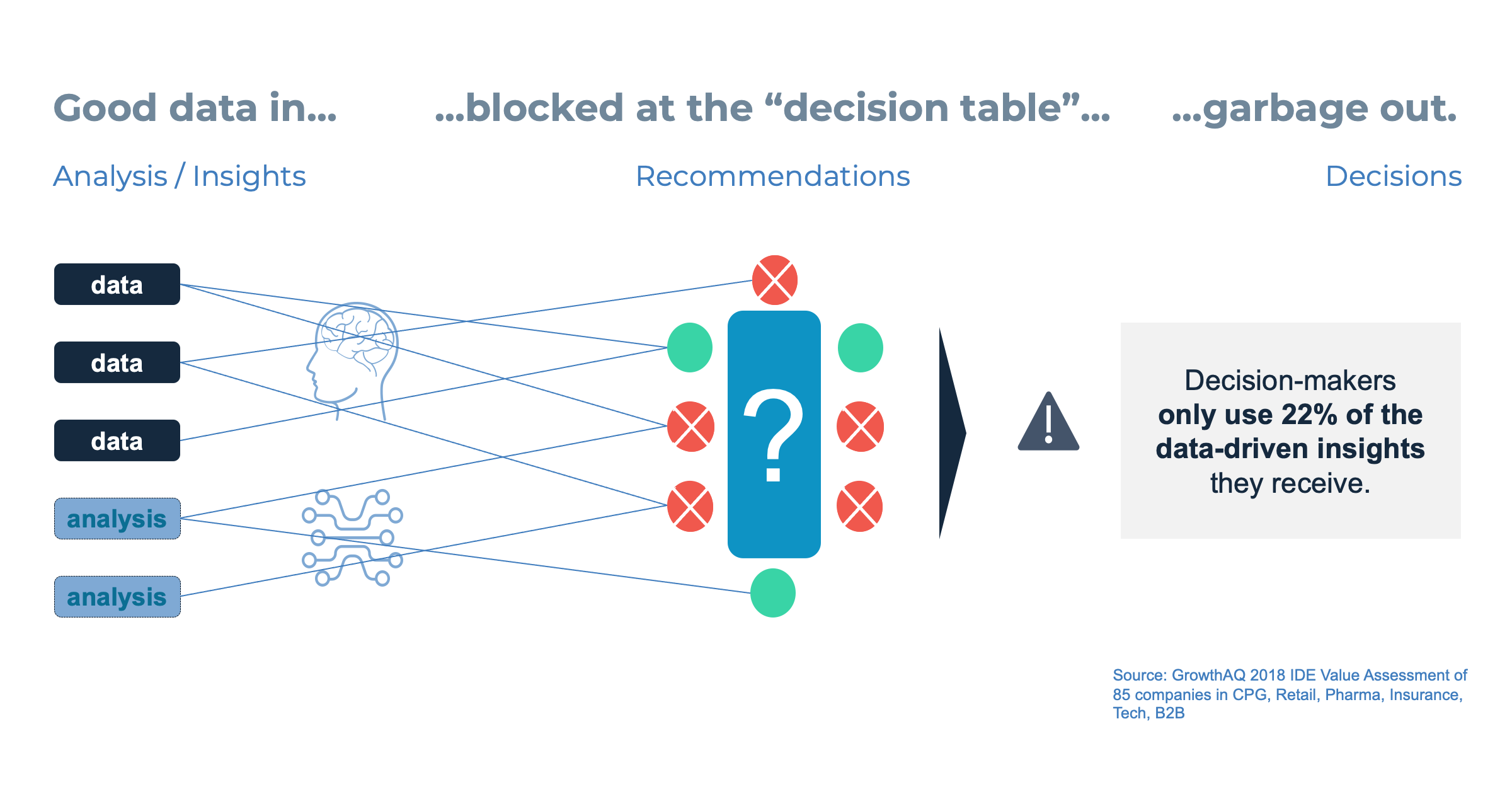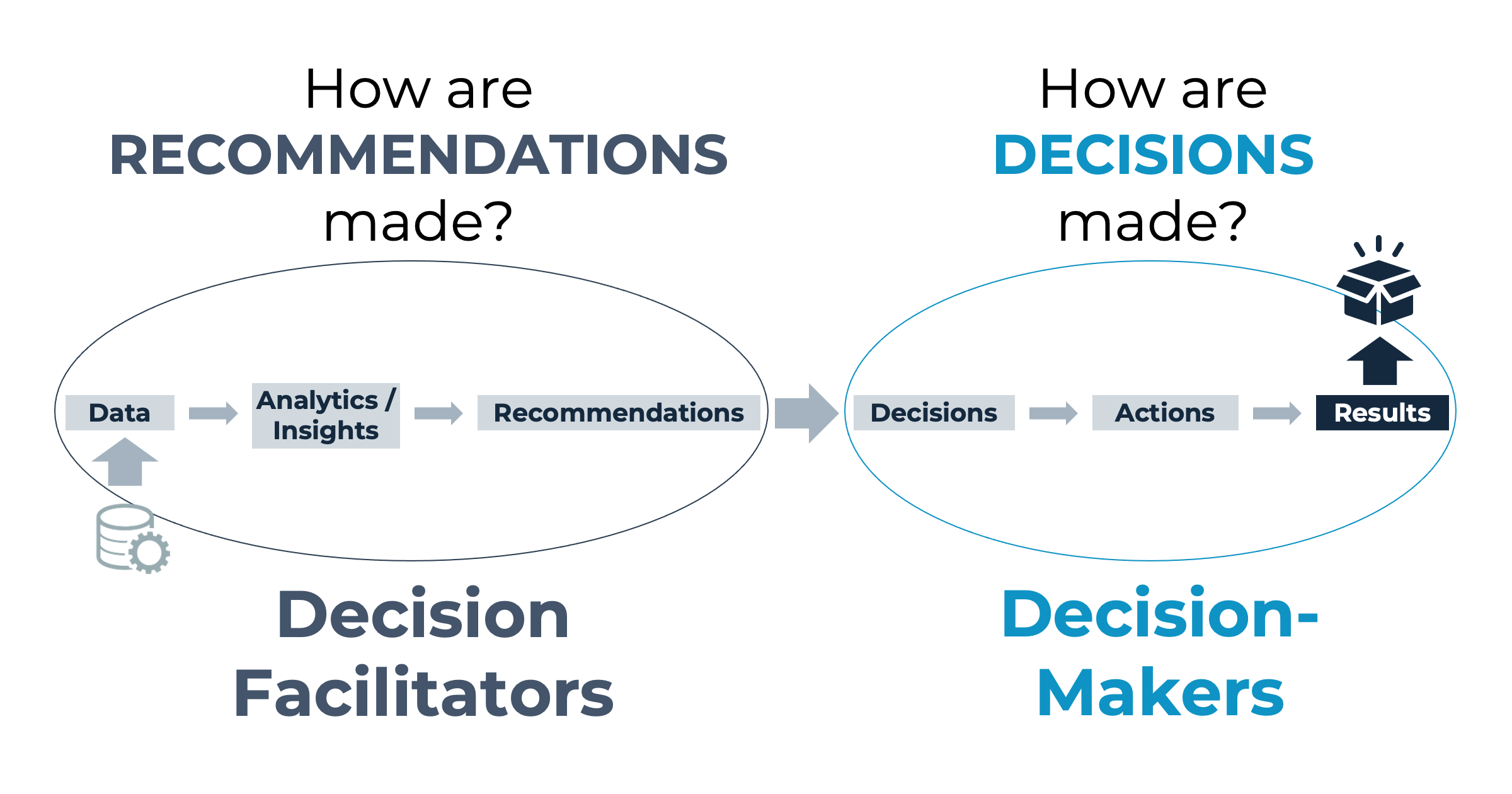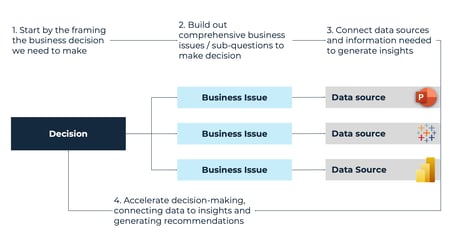Over the past several decades, organizations have invested vast resources in data infrastructure to improve decision success, but the results are mixed. A new approach called “decision-back” flips the conversation on its head.
Instead of working up from the data to analysis and insights, the approach works back from a complete map of the decisions that drive a business to the underlying insights and analysis required to make decisions that consistently achieve business goals and drive growth.
A full explanation of how to apply the approach with several example decisions is available in our free white paper if you’d like to dive deeper.
What’s The Problem?
Billions are spent on new information technology and analytic capabilities to help make better decisions. Yet, 4i’s research found that companies waste 60% of that investment because the resulting analysis and insights generated are not tied directly to decision-making and business results.
This data-to-decision disconnect happens because bottoms-up analytics teams rarely generate analyses and insights that directly address the critical decisions facing their brands and businesses. As a result, top-down decision-makers often ignore the analysis such that data-driven insights and recommendations only make it to the “decision table” 22% of the time, according to a GrowthAQ study.
 Framing The Change
Framing The Change
To understand what must change, think of your organization’s decisions happening across a value chain that involves two prime movers: decision facilitators and decision-makers.
Decision facilitators use data to make recommendations. Their work breaks down into three simple questions:
- Data: What relevant data signals do you have?
- Analysis & Insights: Why are these data signals important?
- Recommendations: Now what should you do based on a complete view of these insights?
The decision facilitator camp includes the insights, analytics, IT, and strategy teams that develop the infrastructure, collect and analyze data and develop recommendations for decision-makers to put into action.
Decision-makers “own” the decisions these recommendations support. Decision-makers own downstream relationships and oversee a combination of decisions that drive their brands and businesses. They develop a holistic assessment of a situation and then take, adjust or reject the recommendations:
- Decisions: What did we commit to doing?
- Actions: Now what do we need to do?
- Results: How did results compare to expectations after implementing the decision, and what did we learn to improve future decision-making?
Decision-makers include general managers, brand managers, and sales leaders responsible for choices ranging from pricing and positioning changes to new product launches and acquisitions.
It is challenging to maintain discipline across this decision value chain. While the model is simple, execution is complex. As a result, real-world decision quality is mixed, leaving a massive source of company value untapped.
The Decision-Back Approach
The decision-back approach uses effective decision-making as the organizing principle for achieving business and financial goals. Decision-back treats decisions like strategic assets and decision-making like a measurable management process.
Thinking “decision-back” involves creating a complete map of decisions required to achieve business and financial goals, then using the map to align employees around an efficient decision-making process driven by relevant analyses and insights.
Putting decision-back into practice requires four steps:
- For each commercial goal, map every associated critical decision made across the relevant functions and departments.
- For each critical decision, create a complete decision tree of key business issues, insights and intuition, experience and data-driven analyses that tie back to the decision.
- For each decision tree, assign the decision facilitators who will make recommendations and decision-makers responsible for the decision result.
- For each decision result, look back across the entire decision-making process to drive continuous learning and performance improvement.
Decision-back initiatives often start with creating trees for a subset of decisions for an essential commercial goal for a core brand or line of business and then expand across all the critical decisions within a business or functional area.

The Results: Faster, Better Decisions, More Engaged Employees
Looking back from business goals to a map of critical decisions that drive goal achievement – and the insights and analysis required for those decisions – creates a predictable, fast, high-quality decision process.
Decision facilitators are more aligned with business goals and more effectively connect the dots, gaining a stronger sense of ownership for the quality of their recommendations and the ultimate business outcomes. In turn, decision-makers receive information and perspectives from various functions and departments organized within the greater context of the decision. Research has shown that this structured decision process speeds time to decision, improves decision quality and increases employee engagement.
Just as important, this decision-back process creates a structured record of the critical decisions made in a business. Organizations can use this record to look back at decision outcomes over time, highlighting opportunities for meaningful employee learning and business performance improvements.
Leaders of sales and marketing functions often describe being customer-centric as thinking “customer-back.” Similarly, it’s time for leaders and managers seeking to unlock decision-making value to think decision-back.

